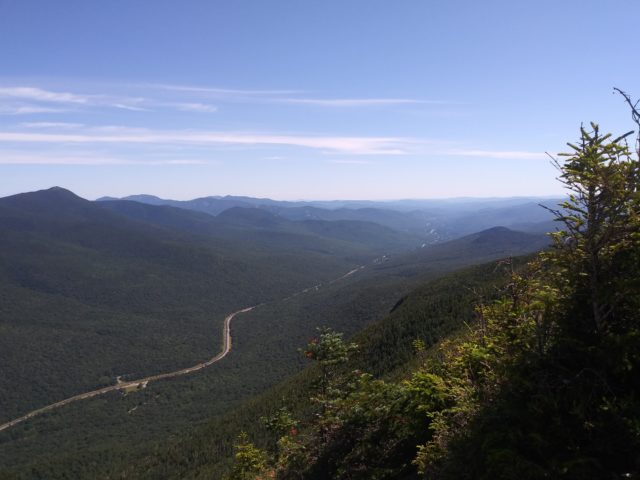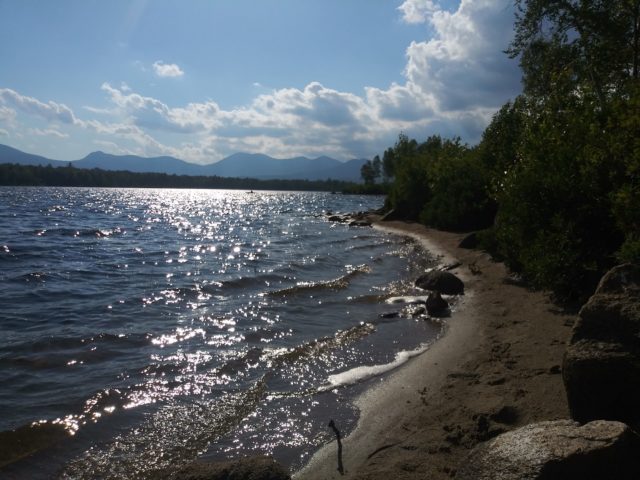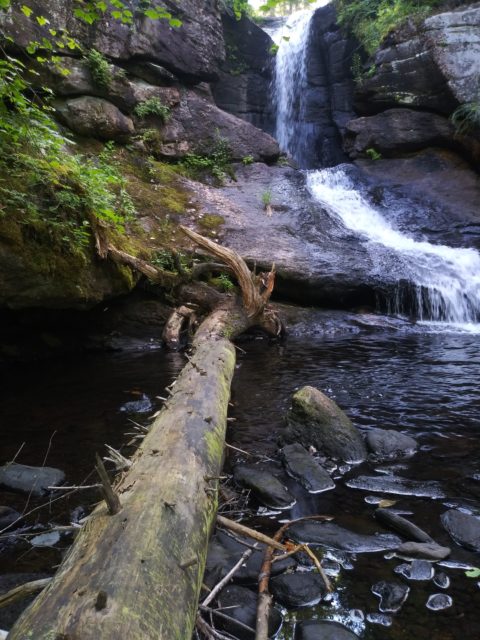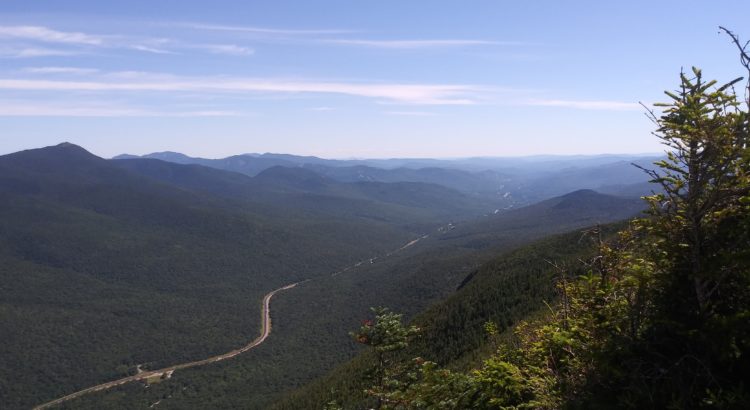Kayla Drake — Discover the Power of Parks Interpretive Ranger — SCA NH Corps
Mindfulness calls to mind an image of someone seated cross-legged, silent except for the occasional “ohm” slipping from their lips. But mindfulness does not have to look like this; it can easily become a part of your everyday life and your outdoor adventures. All it really takes is embracing the present moment.

In fact, the practice of mindfulness is said to benefit well-being, mental health, and even physical health. But what is mindfulness? One definition I like is as follows:
“Mindfulness is the basic human ability to be fully present, aware of where we are and what we’re doing, and not overly reactive or overwhelmed by what’s going on around us.”
Definition by Mindful.org
My positive psychology professor once put it like this: you are either mindful or your mind is full. Discarding some of the relentless thoughts of past and future can help you embrace the present moment; this practice has a multitude of benefits.
When it comes to mental wellbeing, studies show that incorporating mindfulness regularly can reduce negative emotions, such as anxiety and stress. It is also shown to increase self awareness and emotional intelligence. Being mindful can aid in focus and concentration, as well as reducing age-related memory loss. Finally, it can boost resilience, making it easier to bounce back in times of struggle.
As far as physical health, it can improve sleep quality, which is essential to overall health. In addition, studies have found that regular mindfulness can increase overall general health by lowering heart rate and blood pressure; it even boosts your immune system. So, we see that mindfulness is worthwhile in the long term.

Mindfulness for every day life
Here are some simple ways to incorporate mindfulness into your every day life!
1. Use some sort of cue to bring you back to your sensations throughout the day.
Find something to use as a reminder to come back to your senses, to check in with your body and breathing. For example, at every red light you encounter or at every door you walk through, take some deep breaths and take a second to acknowledge the present moment. Use this as a tool to practice noticing your senses throughout the day. You can use any sort of everyday occurence as a cue of this sort, so be creative!
2. Be mindful during chores.
During mundane tasks, like washing the dishes, I tend to notice sensations and practice mindfulness. Rather than shifting into auto pilot mode, notice the simple sensations of the task. Acknowledge what it feels like, sounds like, smells like, looks like, or even tastes like —be careful of this one, most mundane tasks do not taste good!! Focus on your breathing or senses, and this will create a doubly productive use of time; not only are you getting a task done, but you are also checking in with your mind and body through mindfulness.
3. Take some time to be mindful or meditate when you wake up.
Wake up. Rather than looking at your phone, or immediately getting to work on tasks, or hitting snooze, take five minutes. Simply sit up and focus on your breathing. When thoughts pass through, let them pass; let them float by like a cloud in the sky, rather than engaging with them. Gently bring your focus back to your breathing when it begins to stray. Perhaps take a few minutes to stretch your body, in whatever way feels good.
4. Journal.
This is pretty self explanatory, but keeping a journal is a great way to practice mindfulness in your everyday life. It may seem hard to think of things to write about, but you can simply recount your daily happenings. Or you can simply start writing, and words will come. I find that the action of writing things down on paper, by hand, can be very helpful. It can help you make sense of your emotions and also engage your bodily awareness –the action of putting the pen to paper has a special effect.
Mindfulness for your Outdoor Adventures!
As an interpretive ranger in NH State Parks, I cannot recommend this enough: incorporate mindfulness into your outdoor adventures!
Come visit the NH State Parks to reconnect with nature through mindfulness. To practice a moving method of mindfulness, come to Umbagog Lake State Park August 19th and 26th at 10 am for some yoga on the beach. Not near Umbagog? No worries, check out our Discover the Power of Parks Programs schedules, as we offer many exciting opportunities to get outside and learn at the state parks! https://www.nhstateparks.org/news-events/discover-the-power-of-parks

From lakes to mountains to forests, NH State Parks have got it all! Whatever your preference, you can find a place to recreate here in New Hampshire at one of our 93 state parks. You can practice mindfulness outdoors simply by sitting and observing the natural world or by walking and noticing the natural world.
1. Sit and notice
Find a sit spot, which is simply a place in nature where you can sit and observe. Now, a great practice is to find a spot that you sit at regularly, but it is also acceptable to choose a new spot to sit each time you practice this. Anywhere will do, but I like to find somewhere scenic, comfortable, and maybe a bit secluded. Simply sit and observe. This will enhance your relationship with nature and with yourself. Notice something with all five senses, if possible.


2. Walk and notice
Nobody said that minfulness or meditation have to be still; try out a walking meditation. One way to increase mindfulness in your outdoor ambling is to reduce the emphasis on the destination. For example, during a hike, take your time. It is not about getting to the end of the hike; it is not about the destination but the journey! When hiking, it can be easy to get tunnel vision, looking only at the ground ahead of you. So take some time to look up, down, around, and even behind you.
Slow your steps, and notice the world around you. Notice your breathing and your surroundings during your hike. Notice something with all five senses. Most importantly, leave your phone off, unless in case of an emergency. This will help you be more present, more aware, and more in the moment. Taking your time may lead you to pleasant surprises, like this little toad buddy I saw on a tree during a hike!

When you are outdoors, whether hiking or sitting or engaging in other activities, the best way to be mindful is to notice and engage the senses.
1. Listen! I like to tell my friends when hiking to slow down and shut up. Be quiet, and listen very carefully. Nature is known for peace and quiet, but it is far from silent. Perhaps its sounds will speak to you. The wind rushes through the trees with a rustling sound; the birds MAKE SOUNDs; the sound of Britney Spears echoes through the trail (no wait that is not nature, just the inconsiderate person hiking with a bluetooth speaker blaring). The quietude of nature is completely saturated with sounds, if you truly take the time to listen. See if you can pick out individual sounds, such as singular birds amongst the cacophonous birdsong or the sound of each step you take.
2. Feel! Notice the sensations of being immersed in the outdoors, whether it is a cool breeze or the feeling of branches as you brush past them. Notice the textures of the objects you feel around you. Notice anything you feel. This includes emotions, too, so notice how you are feeling in the moment. What emotions come to visit or stay a while?
3. Smell! Notice how the outdoors smells. Whether you’re further north and smelling the fragrant fir trees or you’re by the seacoast smelling the fresh sea breeze, there is definitely always a scent to be noticed. It does sound cliche, but stop and smell the flowers.
4. Really look! Examine the world around you, and see details you have not noticed before. Stop and look at a specific spot, plant, or object; take in every detail of it.
5. Taste, (with caution of course)! You don’t have to forage to notice tastes in nature. Maybe you just savor whatever snack you brought with you. Hold it in your mouth before chewing it up; notice the flavors and textures.
However, you can also find many delectable snacks in nature. I myself cannot resist the wild blueberries, blackberries, and raspberries that abound in our beautiful state. Just remember to always have a positive ID (personally I would recommend triple checking, with three different sources) before eating anything you find outdoors. Seek by inaturalist is one app that can help identify plants or other living things you find outside. Consult with experienced foragers, and be aware of any poisonous look-alikes. Remember, as well, to forage sustainably by taking only what you need; do not take an entire plant or a plant’s entire harvest. For more on foraging and to learn about what you can find to eat in our forests, check out this link! https://blog.nhstateparks.org/tag/foraging/
To me, one of the most important parts of mindfulness is gratitude. Be grateful for this beautiful world that surrounds you.
People usually consider walking on water or in thin air a miracle. But I think the real miracle is not to walk either on water or in thin air, but to walk on earth. Every day we are engaged in a miracle which we don’t even recognize: a blue sky, white clouds, green leaves, the black, curious eyes of a child — our own two eyes. All is a miracle.
Thich Nhat Hanh
Immersing yourself in the sensory experience of the outdoors inherently helps you be grateful for it all. The attitude of gratitude is the number one way to live a happy life — this is not a scientific fact, but it is my own conclusion after a lifetime of anecdotal evidence.
Flow State: mindfulness in outdoor activities
Many people who enjoy the outdoors also enjoy outdoor sports or activities. These can be a window into mindfulness as well; activities like skiiing and watersports can bring about a flow state. The founder of the concept of flow defines it as:
“The state in which people are so involved in an activity that nothing else seems to matter; the experience itself is so enjoyable that people will do it even at great cost, for the sheer sake of doing it.”
-Mihaly Csikszentmihalyi
In other words, a flow state is when you are “in the zone”. It is a mindset that is distinct from our normal mindset; if you have ever lost track of time doing something you enjoy, you may have experienced a flow state.

Hiking, biking, skiing, kayaking, and any other number of outdoor activities can evoke this state. It is a state which comes when the optimal balance between challenge and skill is reached; flow falls between boredom and anxiety.

There are a number of positive emotions associated with the flow state that I could list, but instead I will encourage you to feel this euphoric state for yourself. Different activities work for different people. Do whatever makes you feel in the zone, and do it outside in the beauty of nature!
Conclusion
Mindfulness practices remind us to live in the present, and in doing so, remind us that both the past and the future rely on the present, on the choices we make right now. Choosing to enjoy right now in all of its beauty is the true gift of mindfulness, but it brings with it impacts on the future as well, in the form of long term benefits. Even if you don’t choose to embrace this practice, there is one thing we can all agree on: New Hampshire State Parks deserve to be admired and observed; mindfulness is merely one way to do this.

